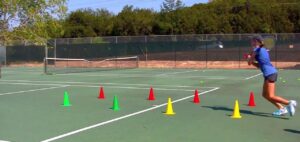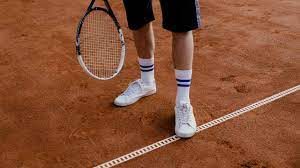What Is Foot Fault In Tennis?
A foot fault occurs when a player steps on or over the baseline while serving in tennis. The baseline is a white line at the end of the court, and the server must remain behind it until after hitting the ball. If the server steps on or over the baseline while serving, they commit a foot fault.
Types of foot fault in tennis
There are two types of foot faults in tennis: technical foot faults and foot faults on the centerline. Technical foot fault happens when the server steps on or over the baseline.
Foot fault on the centerline happens when the server steps on or over the centerline while serving.
How foot faults are called in tennis
Foot faults are called by the chair umpire in tennis matches. The chair umpire is responsible for observing the server’s position and calling foot faults as necessary. When a foot fault is called, the chair umpire announces it to the players and marks it on the scorecard.

Why foot fault matters in tennis
Foot fault is an important rule in tennis as it ensures that players serve from behind the baseline to prevent any unfair advantages. If a server steps over the baseline while serving, it can gain a better angle on its services, giving them an unfair advantage over its opponent. Foot fault helps maintain a fair and equal playing field for all players.
Also, read about What is a Let in Tennis
Consequences of committing a foot fault
The consequences of committing a foot fault depend on the severity of the violation. In most cases, the first foot fault results in a warning from the chair umpire. If a player commits a second-foot fault, they lose a point.
If a player continues to commit foot faults, they may receive a penalty point, a game, or even a match, depending on the severity of the violation.
How to avoid foot faults in tennis
To avoid committing a foot fault in tennis, players must remain behind the baseline while serving. They should also be mindful of their position on the court and ensure that they are not stepping on or over any lines while serving.
Additionally, players can practice proper footwork techniques to improve their balance and reduce the risk of committing a foot fault.
Want to Know about unforced Errors in Tennis Click Here
Tips to prevent foot faults in tennis
To prevent foot faults in tennis, players should follow these tips:
- Proper Foot Positioning: Ensure that your feet are positioned parallel to the baseline and are not touching the baseline or any of the court lines. Keep your weight evenly distributed on both feet.
- Maintain Balance: To avoid foot faults, it’s essential to maintain balance throughout the serve. Make sure you don’t lean forward or backward while hitting the ball.
- Take Small Steps: During the service, avoid taking large steps, as this can often lead to foot faults. Take small, controlled steps to maintain balance.
- Anchor Your Front Foot: It’s essential to keep your front foot anchored to the ground during the serve. If you lift your foot or move it, you may commit a foot fault.
- Practice Proper Footwork: To avoid committing foot faults, it’s important to practice proper footwork and positioning techniques. This can help you improve your balance and positioning on the court.

Common mistakes that lead to foot faults
Foot faults are often the result of poor footwork or incorrect positioning. Some common mistakes that can lead to foot faults include:
- Not standing far enough behind the baseline
- Standing too close to the sideline or centerline
- Taking too large of a step during the serve
- Moving the foot during the serve
- Not maintaining balance during the serve
To avoid committing foot faults, players should practice proper footwork and positioning techniques during their serves.
Foot faults and serving in tennis
Foot faults are most commonly associated with serving in tennis. During the service, the server must stand behind the baseline and hit the ball into the service box on the opposite side of the court. Any violation of this rule, such as stepping on or over the baseline, will result in a foot fault.
Foot faults and returning in tennis
While foot faults are most commonly associated with serving, they can also occur during returning in tennis. During the return, the receiver must remain behind the baseline until after the serve. If the receiver steps on or over the baseline before the service, they commit a foot fault.
Foot Faults and doubles in tennis
Foot faults can also occur in doubles tennis, where two players are on each side of the court. In doubles, players must take turns serving and returning. If either player commits a foot fault, it will result in a penalty for the team.
Foot Faults and Foot Positioning in Tennis
Proper foot positioning is essential to avoid committing a foot fault in tennis. When serving, players should position their feet parallel to the baseline and keep their weight evenly distributed. They should also avoid taking a step before hitting the ball and keep their front foot anchored to the ground during the serve.
The importance of footwork in tennis
Footwork is a crucial aspect of tennis, as it enables players to move around the court quickly and effectively. Proper footwork can also help players avoid committing foot faults by improving their balance and positioning on the court. To improve their footwork, players should practice agility drills, footwork exercises, and court movement techniques.
Conclusion
In conclusion, foot fault is a crucial rule in tennis that all players must understand to compete effectively. By avoiding foot faults, players can maintain a fair and equal playing field and avoid penalties that can affect their performance. By practicing proper footwork and positioning techniques, players can improve their serves and returns and prevent foot faults from occurring.
FAQs
Q. What is the penalty for committing a foot fault in tennis?
A. The penalty for committing a foot fault in tennis can range from a warning to losing a point, game, or even a match, depending on the severity of the violation.
Q. Can foot faults occur during returning in tennis?
A. Yes, foot faults can occur during returning in tennis if the receiver steps on or over the baseline before the serve.
Q. How can players avoid committing foot faults in tennis?
A. Players can avoid committing foot faults in tennis by remaining behind the baseline while serving or returning, practicing proper footwork and positioning techniques, and being mindful of their positioning on the court.
Q. What is the importance of footwork in tennis?
A. Footwork is essential in tennis as it enables players to move around the court effectively, improve their balance and positioning, and avoid committing foot faults.
Q. Why is foot fault an important rule in tennis?
A. Foot fault is an important rule in tennis as it ensures that players serve from behind the baseline to prevent any unfair advantages and maintain a fair and equal playing field for all players.

Hi there! My name is Hamza Rahim and I’m a seasoned tennis player with a passion for helping players of all levels to improve their game. With great experience. I have developed a deep understanding of the sport’s techniques and strategies. I will help tennis lovers to select the best tennis racquets, and balls and also share tips to become the best player on the ground. I hope from my information you will become a great tennis player as well as in your country and also worldwide. And my goal is to provide you with the best information about tennis.











